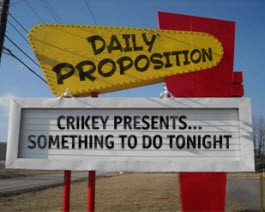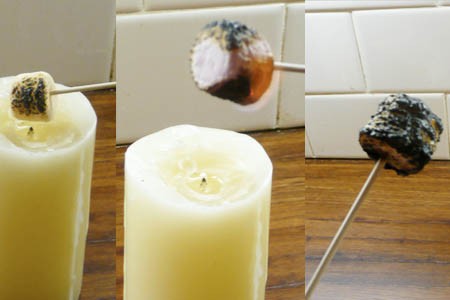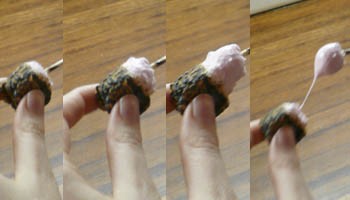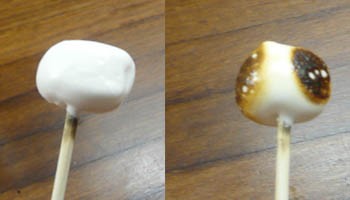
Toasting marshmallows is one of my favourite camping moments. It’s better than fighting over tent pegs, getting campfire smoke in your clothes and having no refrigerator for days. But the worst thing about toasting marshmallows is that it’s usually a strictly camping activity. Or at least, outdoors. Or, at the very least, over an actual fire.
I am making it my personal mission for toasting marshmallows to be an accepted indoors activity over candles. No special event needs to be held for melty marshmallow to be consumed. I am constantly amazed by how few people know this crucial life skill, so let me show you my no-fail, tried-and-tested, candle toasting marshies style, dubbed the Layers Method.
- Take one packet of good quality marshmallows, preferably the four flavour Pascall ones with vanilla, strawberry, banana and apricot.
- Take a candle, any candle. Tealight is fine. Preferably not scented. Light candle.
- Grab a skewer stick from the kitchen cupboard. Poke it through the marshmallow, careful to not poke it the whole way through otherwise you’ll end up with burnt bits of stick in your marshmallow when you pull it off.
- Hold your marshmallow over the candle until it catches on fire. I know this breaks with common campfire convention, but there isn’t enough heat in a candle to toast it any other way (unless you have the patience of a saint and hold your measly skewer over the candle for hours — stuff that). Basically you go around the marshmallow, carefully setting each little bit on fire before blowing it out. If you don’t burn the entire marshmallow, including the bit closest to the stick, then you will have major problems at the next –and most important — step. The process should resemble something like this:
- Now comes the tricky bit: pulling off the layer. This process is called the Layers Method for a reason: eating a marshmallow in layers is the most tasty way of eating and it savours the entire marhsmallow. So, gently grab your blackened marshmallow and pull it up and off the stick in the opposite direction of how you put it on. Don’t go crazy and try and pull it off sideways, it will leak goo everywhere. Instead, it should look something like this:
- Then, it’s essentially ‘repeat steps 4 and 5’. Except, only the first layer ever burns, the second (and if your marshmallow isn’t completely consumed, third) never burns over a candle, instead gently browning thanks to unknown sugar science. As a nice touch, this layer swells as you heat it, meaning more tasty mashmallow goo. (Note, this picture shows a darker layer than normal. I was talking while toasting.)

That looks disgusting, you’re thinking. Well, you will be wrong. I promise.

Eat the tasty black ball of burnt goodness. I assure you it will be delightful. Since the candle isn’t producing that much heat, the burnt bit isn’t bitter and instead has a lovely gooey interior. While you can lick any of the melty goo hanging off the skewer stick, leave the remaining marshmallow ball on it.

Imagine your next dinner party, everyone sitting around the table with an individual candle and skewer, toasting their own marshmallow. An event worthy of a singalong.








How bizarre, I’ve never noticed a weird taste and I’ve tried this with heaps of friends and no one has ever mentioned an odd taste. I am, however, horrified that I am potentially killing/poisoning readers.
Dear Amber, you are clearly a profoundly damaged person.
But fortunately, there is absolutely NO chance of you ever suffering from anorexia.
P.S. The apricot tastes best. 🙂
I think this is a crook idea, mostly due to the presence of the candle.
Candles burn by using some of their heat to melt the candle wax, which is then drawn up the wick. In the wick it keeps getting hotter until the wax vapourises and then mostly catches on fire.
The problem is that some wax doesn’t burn and some doesn’t burn completely. So, in the stream of stuff coming off the top of the flame are some compounds that are the result of combustion and some vapourised and unburnt wax.
This stream bumps into the marshmallow, which will be cooler than the flame. This causes some of the combustion products to precipitate out of the stream and collect on the mashmallow. This is crook.
The difference between this and toasting them over a fire is that a proper fire has radiant heat. A candle isn’t big enough.
Paddy, apricot is my favourite too.
And Eponymous, I appreciate your comment, but am slightly confused. Are you saying that you will actually be ingesting combustion products when burning over a candle? Is there something particularly bad about doing this? (I’m asking quite genuinely).
Yeah Amber, almost certain you’ll be comsuming combustion products and some wax if you eat the mashmallows.
The problem with combustion is that as each molecule is broken up and oxidised funny things happen. Ideally all that would come out is CO2 and water (which would both be quite non-toxic), but because it’s open combustion almost any combination of carbon, hydrogen and oxygen could come out the other end; this includes a HUGE range of chemicals, some poisonous, some not.
Seriously, the risk is probably very low, but I’ve done it before and don’t like the taste.